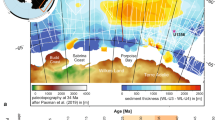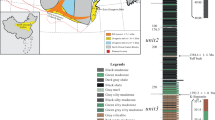Abstract
SUBTROPICAL ocean gyres are considered to be the marine analogues of terrestrial deserts because of chronic nutrient depletion and low standing stocks of organisms1. Despite their presumed low rates of primary and export production, oligotrophic habitats contribute significantly to global productivity because of their large extent2. Therefore, even small changes in ecosystem production can produce large effects in the global carbon cycle. The North Pacific subtropical gyre has generally been thought to support a homogeneous, stable biological community3,4, but recent investigations have suggested instead that the ecosystem of this gyre is temporally and spatially variable5–7. The causes of this variability are not well understood. Here we present evidence of a major change in the structure and productivity of the pelagic ecosystem in the subtropical North Pacific Ocean, an effect that we attribute to the 1991–92 El Niñe–Southern Oscillation (ENSO) event. Decreased upper-ocean mixing and a change in circulation resulted in an increased abundance and activity of nitrogen-fixing micro-organisms and a shift from a primarily nitrogen-limited to a primarily phosphorus-limited habitat with attendant changes in total and export production and in nutrient cycling pathways and rates.
This is a preview of subscription content, access via your institution
Access options
Subscribe to this journal
Receive 51 print issues and online access
$199.00 per year
only $3.90 per issue
Buy this article
- Purchase on Springer Link
- Instant access to full article PDF
Prices may be subject to local taxes which are calculated during checkout
Similar content being viewed by others
References
Berger, W. H. in Productivity of the Ocean: Past and Present (eds Berger, W. H., Smetacek, V. S. & Wefer, G.) 429–455 (Wiley, New York, 1989).
Martin, J. H., Knauer, G. A., Karl, D. M. & Broenkow, W. W. Deep-Sea Res. 34, 267–285 (1987).
McGowan, J. A. & Hayward, T. L. Deep-Sea Res. 25, 771–793 (1978).
McGowan, J. A. & Walker, P. W. Ecol. Monogr. 49, 195–226 (1979).
Star, J. L. & Mullin, M. M. Deep-Sea Res. 28A, 1303–1322 (1981).
Venrick, E. L. Deep-Sea Res. 37, 1017–1031 (1990).
Polovina, J. J. et al. Fish. Oceanogr. 3, 15–21 (1994).
Karl, D. M. & Winn, C. D. Envir. Sci. Technol. 25, 1976–1981 (1991).
McPhaden, M. J. Oceanography 6, 36–44 (1993).
Redfield, A. C., Ketchum, B. H. & Richards, F. A. in The Sea, Ideas and Observations on Progress in the Study of the Seas Vol. 2 (ed. Hill, M. N.) 26–77 (Interscience, New York, 1963).
Laws, E. A. & Bannister, T. T. Limnol. Oceanogr. 25, 457–473 (1980).
Karl, D. M. Microbiol. Rev. 44, 739–796 (1980).
Firing, E. Deep-Sea Res. (submitted).
Carpenter, E. J. & Price, C. C. Science 191, 1278–1280 (1976).
Carpenter, E. J. & Romans, K. Science 254, 1356–1358 (1991).
Karl, D. M. et al. in Marine Pelagic Cyanobacteria: Trichodesmium and other Diazotrophs (eds Carpenter, E. J., Capone, D. G. & Rueter, J. G.) 219–237 (Kluwer, Dordrecht, 1992).
Devassy, V. P., Bhattathiri, P. M. A. & Quasim, S. Z. Indian J. Mar. Sci. 7, 168–186 (1978).
Capone, D. G., Ferrier, M. D. & Carpenter, E. J. Appl. envir. Microbiol. 60, 3989–3995 (1994).
Glibert, P. M. & Bronk, D. A. Appl. envir. Microbiol. 60, 3996–4000 (1994).
Barber, R. T. in Primary Productivity and Biogeochemical Cycles in the Sea (eds Falkowski, P. G. & Woodhead, A. D.) 89–106 (Plenum, New York, 1992).
Barber, R. T. & Chavez, F. P. Science 222, 1203–1210 (1983).
Wilkerson, F. P., Dugdale, R. C. & Barber, R. T. J. geophys. Res. 92, 14347–14353 (1987).
Jacobs, G. A. et al. Nature 370, 360–363 (1994).
Michaels, A. F. et al. Deep-Sea Res. 41, 1013–1038 (1994).
Blatter, H., Funk, M. & Ohmura, A. Atlas of Solar Climate for the Period from 200000 B.P. to 10000 years A.P. (Heft 10, Geographisches Institut, Zurich, 1984).
National Oceanic and Atmospheric Administration Local Climatological Data Honolulu, Hawaii. Monthly Summary (Environmental Data & Information Service, National Climate Service, Asheville, North Carolina, 1989–92).
Letelier, R. thesis, Univ. Hawaii (1994).
Troup, A. J. Q. JI R. met. Soc. 91, 490–506 (1965).
Wyrtki, K. J. phys. Oceanogr. 5, 572–584 (1975).
Author information
Authors and Affiliations
Rights and permissions
About this article
Cite this article
Karl, D., Letelier, R., Hebel, D. et al. Ecosystem changes in the North Pacific subtropical gyre attributed to the 1991–92 El Niño. Nature 373, 230–234 (1995). https://doi.org/10.1038/373230a0
Received:
Accepted:
Issue Date:
DOI: https://doi.org/10.1038/373230a0
This article is cited by
-
Monitoring ocean biogeochemistry with autonomous platforms
Nature Reviews Earth & Environment (2020)
-
Changes in the North Pacific subtropical gyre under 1.5 °C low warming scenario
Climate Dynamics (2020)
-
Phytoplankton communities determine the spatio-temporal heterogeneity of alkaline phosphatase activity: evidence from a tributary of the Three Gorges Reservoir
Scientific Reports (2017)
-
Meridional and seasonal footprints of the Pacific Decadal Oscillation on phytoplankton biomass in the northwestern Pacific Ocean
Journal of Oceanography (2016)
-
Nitrogen Uptake Dynamics in a Tropical Eutrophic Estuary (Cochin, India) and Adjacent Coastal Waters
Estuaries and Coasts (2016)
Comments
By submitting a comment you agree to abide by our Terms and Community Guidelines. If you find something abusive or that does not comply with our terms or guidelines please flag it as inappropriate.



